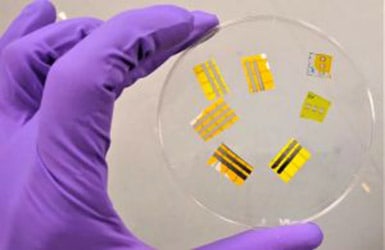Tattoos are usually considered a form of personal expression, but a team of researchers in Europe have created what they’re say is world’s first light-emitting tattoo based on organic light emitting diode (OLED) screen technology that could serve as a visible warning about potential health issues or even to warn if food has passed its expiry date.
As we all know tattoos are mostly used to show just how much people love their moms, according to the article in Gizmodo. But there’s also a precedent for tattoos being used as a medical tool. Cancer patients undergoing radiation therapy who are tattooed with small dots used as reference marks, for precisely targeting the machines used for treatments during repeat sessions, is one example.
In a recently published paper in the Advanced Electronic Materials journal, “Ultrathin, Ultra?Conformable, and Free?Standing Tattooable Organic Light?Emitting Diodes” scientists from University College London in the UK and the Italian Institute of Technology detail how their new approach to tattoos relies on the same OLED technology featured in devices like more recent iPhones. The flexibility of an OLED display is important for this application given human skin (or most perishable food) is pliable.
The light-emitting tattoos, made from an extremely thin layer of an electroluminescent polymer, glow when a charge is applied. They measure just 2.3-micrometers thick, which, according to the researchers, is about one-third the diameter of a red blood cell. The polymer layer is then sandwiched between a pair of electrodes and sits on top of an insulating layer. This is bonded to temporary tattoo paper through an inexpensive printing process which, says the research team, is scalable too.
Tattoos can be applied to surfaces using the same simple wet transfer process that temporary tattoos use and can be easily washed off when no longer needed or wanted using soap and water. With a current applied the OLED tattoos in their current form simply glow green, but eventually could produce any colour, using the same RGB approach that OLED screens use.
However, while the researchers see great potential for the tattoos as a medical tool, or they could start flashing when an athlete needs to rehydrate. From a packaging perspective they would change colour when applied to certain foods which change moisture content when close to spoiling. So far this is a technology under development, but it has been applied to a plastic bottle, an orange and some paper packaging. Applying the tattoos to fruit to signal when it is past its expiry date is a particular target development area.
Packaging 360 is a comprehensive knowledge sharing ecosystem for the Indian packaging industry. Our services include an online content platform to deliver news, insights and case studies; organising conferences seminars and customised training; Providing Bespoke Project Consulting, Market Research and Intelligence.







